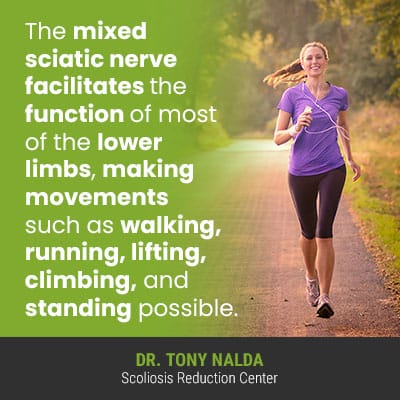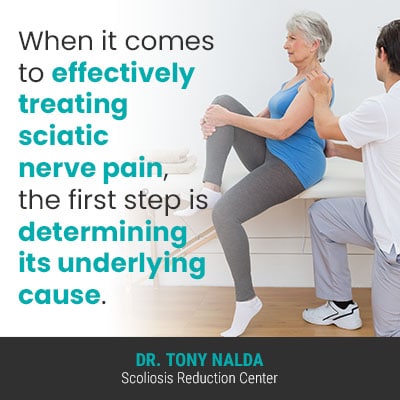Sciatic nerve pain can range from mild, with intermittent flare-ups to chronic and debilitating. While some cases of mild sciatica can resolve on their own in a matter of weeks or months. Those caused by an underlying condition require proactive treatment that addresses sciatic nerve pain as a symptom and its underlying cause.
Most hospital visits for sciatica involve a trip to the emergency room for intense flare-ups requiring immediate pain relief. However, these visits are done for symptom management rather than comprehensive treatment, because the prescription of pain meds is the typical priority of ER departments.
What is Sciatica?
Many think of sciatica as a condition itself, but it’s more accurate to consider sciatica as a symptom of an underlying condition.
Sciatica involves pain and/or discomfort felt anywhere along the sciatic nerve’s pathway, which is extensive.
The sciatic nerve is the longest and largest of the human body and starts in the lumbar spine (lower back) and extends down the buttock, thigh, leg, and foot.
Most often, sciatic nerve pain is felt on one side of the body, most commonly the left, but can involve both.
The sciatic nerve includes the union of sensory and motor-sensory fibers that supply most of the thighs, legs, and feet.

The mixed sciatic nerve facilitates the function of most of the lower limbs, making movements such as walking, running, lifting, climbing, and standing possible.
When the sciatic nerve is inflamed, irritated, and/or damaged, it can make a leg feel stiff, inflexible, and have a decreased range of motion; it can cause debilitating radicular pain, muscle weakness, and/or tingling anywhere along the nerve’s pathway: lower back, buttocks, leg(s) weakness, and feet.
When the sciatic nerve is exposed to uneven forces, it can cause nerve compression and/or impingement (a loss of space for the nerves to function within). This can occur in the lumbar spine at the nerve-root level, where it starts, or anywhere along the nerve’s pathway.
Most often, sciatica symptoms are felt in the areas closest to the affected leg nerve.
When a nerve root is involved, the condition is called lumbar radiculopathy but is commonly referred to as sciatica.
As mentioned, in most cases, sciatica affects one side of the body, depending on which leg is supplied by the affected nerve: left or right.
There are cases where both sides of the body are affected, but this is rare, and depending on a variety of factors, including causation, sciatic nerve pain can range from mild to severe pain.
Sciatica and Pain Management
When it comes to options for managing sciatic nerve pain, those asking, “What will the hospital do for sciatica pain,” are likely referencing situations where pain flares up intensely, requiring immediate relief.
While hospital policy and procedure can differ from one location, jurisdiction, and state to the next, in general, a trip to one’s local emergency room department is more about short-term pain relief than long-term sustainable improvement based on comprehensive assessment and diagnosis.
As mentioned, in order for sciatica to be treated effectively, it has to be regarded as a symptom, and not a condition itself, meaning its underlying cause has to be determined and shape the crafting of effective treatment plans.
Most likely, if someone is experiencing a sciatic nerve pain flare-up that is so intense it requires a trip to the hospital, the issue will likely be addressed with prescription pain medications and a recommendation to follow up with a visit to the patient’s regular general practitioner (GP).
In some cases, epidural lumbar steroid injections can be given if scans are done and show inflammation, and when guided by ultrasound, results can be precise, but this is more of a short-term solution and won’t produce long-term sustainable pain management and improvement, particularly when the underlying cause of the inflammation hasn’t been addressed.
Trips to the hospital for an unbearable sciatica pain flare-up can also involve an X-ray to confirm the pain is not from a recent spinal injury, particularly if the underlying cause of the sciatica has not yet been determined.
The more relevant question then becomes, “What can I do for sustainable and long-term sciatica pain relief?”
How to Effectively Treat Sciatic Nerve Pain

When it comes to effectively treating sciatic nerve pain, the first step is determining its underlying cause.
Sciatica has a number of causative sources, the most common being spinal degeneration, intervertebral disc issues, and/or the presence of spinal conditions such as stenosis or scoliosis.
Here at the Scoliosis Reduction Center®, I perform a comprehensive physical exam if a patient comes to me concerning sciatic nerve pain. When necessary, an X-ray could be recommended to see what is happening in and around the spine.
You may also like: How To Cure Sciatica Permanently
While there are no treatment guarantees, once the underlying cause is determined, a treatment plan can be customized and crafted to address the specifics of a patient’s sciatic nerve pain, including severity, experienced symptoms, and causation.
For example, spinal degeneration is a common cause of sciatica, and this involves the natural age-related deterioration of the spine, and the cumulative effect of certain lifestyle choices.
While a certain amount of spinal degeneration is to be expected with age, relevant lifestyle choices can also play a role in either increasing or decreasing degenerative changes.
When it comes to lifestyle, maintaining a healthy weight and activity level is important as it means the spine and its joints are not strained and exposed to uneven wear and tear, and the spine and its surrounding muscles are kept as strong, loose, and flexible as possible; strong core muscles mean a spine that is optimally supported and stabilized, taking pressure off the spine and its parts.
For the spine to function optimally, it has to maintain its natural curves and alignment, and the intervertebral discs are a big part of that ability; and as the first spinal structures to feel the effects of degeneration, disc health and function are related to sciatica.
As the discs sit between adjacent vertebrae (bones of the spine), if they experience a change in shape and/or function, it can affect the bones connected and the structure and integrity of the entire spine.
If issues such as degeneration, disc desiccation, bulging, and/or herniated discs develop in the lumbar spine, they not only impact the spinal section where the disc is located but also its surrounding nerves, including the sciatic nerve.
When a disc degenerates, it tends to become desiccated, losing fluid and height, and this change in shape affects the position of adjacent vertebrae.
When a disc becomes bulging or herniated, this means the disc is encroaching on the spice within the spinal canal, through which the sciatic nerve travels and branches out to different areas of the body.
Remember, the spine and brain work in tandem to form the body’s central nervous system, facilitating brain-body communication.
If the sciatic nerve is being compressed due to a structural change in the spine and/or a loss of space in the spinal canal, causing sciatic nerve impingement, improvements made to disc health and function address the underlying cause and can make improvements to daily life and pain management.
If conditions like stenosis or scoliosis are determined to be the underlying cause of sciatic nerve compression and/or impingement, integrating multiple condition-specific treatment modalities such as in-office physical therapy, custom-prescribed home exercises, chiropractic care, corrective bracing, and apportioning them accordingly, can improve spinal health and function, reducing nerve compression.
In hospitals, the primary focus is on addressing acute sciatica pain, not on providing comprehensive solutions for how to cure scoliosis, dextroscoliosis, or similar conditions.
When it comes to addressing scoliosis and sciatica pain, hospitals may offer various treatments, including surgical options like scoliosis surgery, herniated disc surgery, or kyphosis surgery, each with its associated costs, which can vary depending on the specific procedure and individual case.
Conclusion
When it comes to sciatic nerve pain, we are talking about a number of sensations from lower back pain to radicular pain that can include sensations of electric-like shocks, tingling, and/or numbness down the leg and into the foot.
In most cases, sciatica affects the left side of the body, but it can involve the right side and, in rare cases, both.
In cases of sciatica pain exacerbated by conditions such as c5-c6 disc bulging, cervical radiculopathy, or spondylolisthesis, understanding the hospital’s treatment options can provide valuable insights.
The sciatic nerve is the longest and largest nerve in the human body consisting of mixed sensory and motor fibers that originate in the lumbar spine (lower back) and extend down the buttock, leg, and foot, and sciatic nerve pain can be felt at the nerve root in the lumbar spine, or anywhere along its extensive pathway.
Sciatic nerve pain is caused by uneven forces being exposed to the sciatic nerve, including compression and/or impingement, and this irritates the sciatic nerve and can cause irritation, inflammation, and damage. Nerve damage and its effects are considered the last stages of sciatica.
Sciatic nerve pain can range from mild and intermittent to chronic and debilitating, and flare-ups can be painful, and intense, sending people to the hospital for immediate pain relief; while each case is unique, in most cases, trips to the hospital for intense pain involves the Emergency department, which is more focused on symptom management than long-term treatment and assessment.
Most trips to the hospital for chronic sciatica pain will involve prescription pain meds, sometimes including steroid injections, but for long-term sustainable improvement, proactive treatment driven by the underlying cause of the sciatic pain is necessary.
Also known as lumbar radiculopathy, sciatica has different causes including natural age-related spinal degeneration, intervertebral disc issues, and the presence of an underlying spinal condition such as stenosis or scoliosis.
Here at the Scoliosis Reduction Center®, I believe in proactive treatment that addresses a condition’s underlying cause; this is a key difference between merely treating a symptom, or the underlying condition itself.
Through the application of condition-specific chiropractic care, in-office therapy, and custom-prescribed home exercises, I can help make improvements to overall spinal health and function by preventing further damage, increasing core strength, restoring disc function and healthy spinal curves, creating more space for the spinal nerves, and reducing nerve compression.





